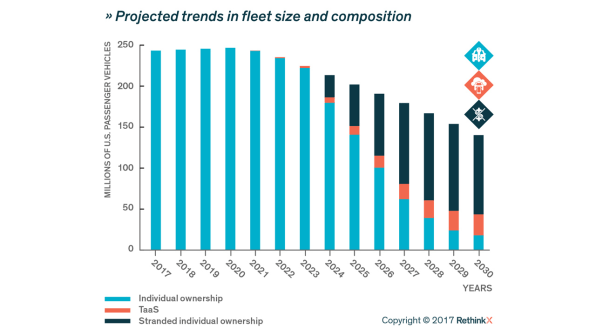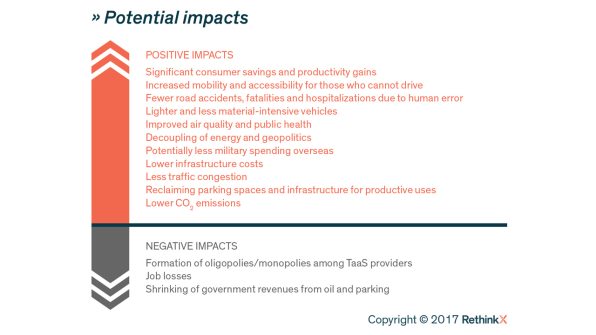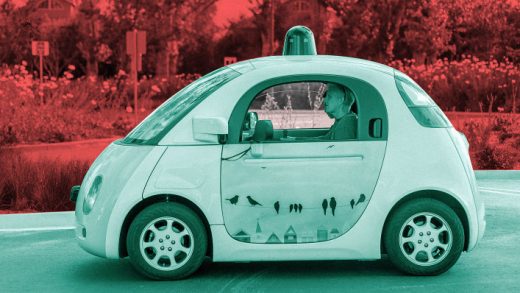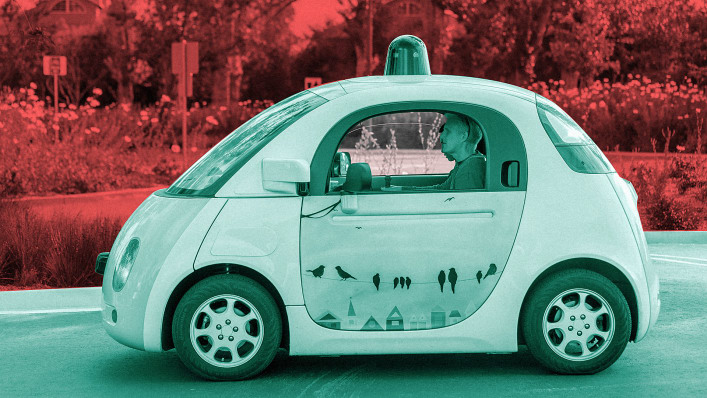It Could Be 10 Times Cheaper To Take Electric Robo-Taxis Than To Own A Car By 2030
Ask a typical industry analyst how long it might take Americans to take most trips in electric cars, and they might say the middle of the century–or later. The Energy Information Administration predicts that only about 3% of miles traveled in the U.S. in 2050 will happen in electric cars. But a new report suggests that it could happen in a little more than a decade.
Self-driving cars, the report predicts, will make ride hailing so cheap that the market will quickly transform–and because electric cars can last longer with heavy use, it will make economic sense for those cars to be electric, as well. By 2030, 95% of passenger miles traveled in the U.S. could be happening in on-demand, autonomous electric cars owned by fleets rather than individuals. The average family could be saving $5,600 a year on transportation. Also, the oil industry could collapse.

The linear, incremental growth of electric vehicles predicted by some analysts might be wrong. “This is not an energy transition,” says James Arbib, a London-based venture investor who co-authored the Rethinking Transporation report with serial entrepreneur and author Tony Seba. “This is a technology disruption. And technology disruptions happen in S-curves. They happen much more quickly.”
Arbib and Seba saw that policymakers and others tend to make decisions without understanding how exponential change happens, and founded a new nonprofit, RethinkX, to study those disruptions. The transportation report is their first.

The report predicts that autonomous cars could be ready for widespread deployment–and have regulatory approval–by 2021. The exact year may vary, but the researchers have confidence it will happen between 2020 and 2025, based on announcements from car companies and how quickly self-driving pilots are growing. They also believe that regulators will want to support the technology.
“There are enormous gains for the economy, gains on a social and environmental level, and so on, and we think that generally there will be a supportive attitude,” says Arbib. “Any technology that can save a number of lives as autonomous vehicles might do–there’s sort of a moral imperative to try to introduce it when you can. From a regulatory perspective, we expect there to be a supportive framework.”

Within 10 years–after the technology is ready and regulators have approved it–even though individually owned gas cars will still exist, the report predicts that virtually all trips will happen in electric robo-taxis.
The shift will happen because of economics: using “transportation as a service” in autonomous electric cars could be 4 to 10 times cheaper per mile than buying a new car, and 2 to 4 times cheaper than operating your own, old car. Ride hailing in a car shared with other passengers–like UberPool today, but without a human driver–could cost as little as three cents a mile.
The cars will be cheaper, the report posits, for several reasons. Because self-driving cars almost eliminate the possibility of accidents, the cost of insurance could be far less. Because the cars will be driven far more of the time–the typical personal car is used only 4% of the time–the depreciation cost per mile would also be sharply reduced. The cost of charging a battery is less than buying gas. And electric cars also require less maintenance and last longer on the road.
“It all comes down to vehicle degradation, essentially,” says Arbib. “When you compare the powertrain of an electric vehicle to a gasoline vehicle, there are about 20 moving parts in the power train of an electric vehicle, and 2,000 or so in a gasoline vehicle. So there’s just a lot more that can go wrong in a gasoline vehicle.” Heat and vibration in a gas car also make it degrade faster. If a typical gas vehicle lasts 200,000 miles at the most, an EV could easily last 500,000 miles; the report authors predict that by 2030, they might last for as many as a million miles. (Elon Musk, of course, has already talked about designing a Tesla that lasts that long.)
The cars will be so cheap to operate that, in some cases, companies might offer transportation to their workers for free. Businesses may choose to make money by offering the vehicles for ad space, or selling data as the cars travel, or selling the service of plugging the cars into the electric grid to manage the storage of renewable energy. The technology could yield new business models, like mobile coworking spaces or cafes in larger self-driving vehicles that offer free rides as you drink your coffee.
“Take Starbucks,” says Arbib. “I live in London, and I would imagine that the rent on a store in London would be £100,000 a year, or more in the center of town. Think what that translates into per coffee sold. It might be that Starbucks finds it cheaper to have a fleet of 20-seater buses that they kit out as mobile cafés that roam the streets on popular routes.”
If consumers can save so much more money by using transportation as a service, it’s likely that they’ll make the shift quickly. And since electric cars are an important part of the service, they can grow exponentially, too. In the past, Arbib says, most analysts have compared electric cars to individually owned gas cars.
“That’s a much slower transition,” he says. “The EV only becomes competitive on an upfront cost basis at some point in the ’20s and then gradually gets cheaper and cheaper, but it’s only ever a few percent cheaper. It’s not many multiples cheaper. This is an economic-driven transition, and we think the size of the cost difference is what drives it.”
The report also looked at how the changes will feed on each other. As gas cars become less common, at some point, gas stations will start to close, making it less convenient to get fuel. Mechanics will start to close, and parts will get harder to find, pushing more people away from traditional cars. As self-driving cars grow on roads–potentially getting their own lanes so they can travel efficiently–driving yourself may become less and less convenient.
The shift would lead to multiple major changes. Former drivers, no longer stuck in traffic, would be more productive, and add $1 trillion to the economy. Consumers would collectively have an extra $1 trillion to spend because of their savings on transportation costs. People who couldn’t afford to drive (or who couldn’t physically drive) in the past would have better access to jobs or school. With more efficient use of cars, there would be fewer vehicles on roads; parking lots in cities could be used for housing or other uses than storing cars. Because self-driving cars avoid accidents better than humans, streets would be safer. Pollution would dramatically drop.
There would also be challenges. The report predicts catastrophic effects for the oil industry as early as 2021. The affordability of the new system could tempt some commuters to abandon trains and subways, even though they’re better at moving large crowds of people. (Arbib points out that this is less likely to be a challenge in the U.S., where the vast majority of trips already happen in cars.) Some temporary congestion on roads could also be overcome if every vehicle becomes autonomous, and cars can travel closer together and faster.
“I think there will come a time where we actually decide to ban human drivers in cities,” he says. “It’s either going to be on congestion or speed grounds as people will actually see the huge gain that comes with taking humans out of the equation. Or it might be on safety grounds . . . once it’s proven that autonomous vehicles are having almost no accidents and human drivers are still killing kids on streets, public opinion might shift and it might be seen as recklessly dangerous to be a human driver.”
While policymakers could speed up the transition–or potentially slow it down–Arbib thinks it is likely to happen. “There’s a global marketplace here,” he says. “The more vehicles there are on the road, the more quickly they learn. If America, or any particular state in America, decides to hold back, we still expect the Chinese or Singapore or perhaps London to go ahead and pilot and test and develop these vehicles. The regions that don’t adopt this will be left behind, and will have to play catch up.”
A new report predicts that we’re on the edge of an incredibly rapid transition to an entirely new transportation system–where it will be so much cheaper and easier to not own a car, you’ll get rid of it as soon as you can.
Ask a typical industry analyst how long it might take Americans to take most trips in electric cars, and they might say the middle of the century–or later. The Energy Information Administration predicts that only about 3% of miles traveled in the U.S. in 2050 will happen in electric cars. But a new report suggests that it could happen in a little more than a decade.
Fast Company , Read Full Story
(42)



